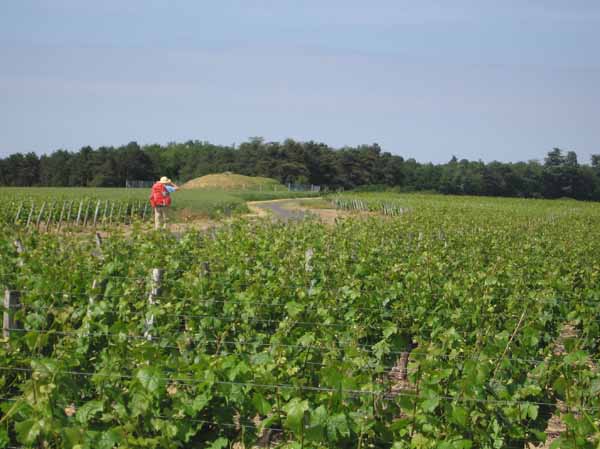Tuesday, 31 May 2005
Distance 22 km
Duration 5 hours 0 minutes
Ascent 115 m, descent 103 m
Map 26 of the TOP100 blue series (now superseded)

The night had been dewy and our washing was not dry. Nor was the tent, so we left them steaming in the morning sun and walked back to the village for coffee. We already had a good layer of muesli and nectarines inside us.
At a bar facing a small square, the outside tables were empty in the early chill, but indoors, amongst the lace curtains and big vases of flowers, there was quite a gathering of locals.
We spent a restful half-hour there reading the paper with our coffee.

Back at the camping ground, we shouldered our packs and marched off down the Cher.
So far on this trip our powers of navigation had not been very impressive (for which we blamed the lack of a map), but today we only had to stay close to the river, preferably on the GR41.

Before long we found ourselves turning away from the river, crossing under the railway line and climbing a ridiculously steep dirt road, which brought us out onto a spreading landscape, with vines as well as cereals in the fields.
In a shallow valley nearby, sunless and dank at this hour, was a cluster of old houses, the top of the town of Chissay.
We arrived in Chissay from above and some women told us there was a bar down on the main road, at the hotel. It turned out rather unprepossessing, with no terrace and a dim, stuffy interior, but we had coffee anyway, then continued down to the river. On the way we saw the wonderful château of Chissay, which is now an expensive hotel.

Back under the railway line, we took the riverside cycle path and stopped for lunch on a stone slab beside the water. At Chisseau there was a camping ground but we felt sure there would be another one closer to Chenonceaux, our destination for the day.
Soon our way was barred by the moat surrounding the Château de Chenonceaux.
We caught a glimpse of the last arches of the castle straddling the river, before the path turned away beside the thickly wooded royal enclosure.

When we emerged we were in a gypsy camp full of importunate kids and immediately beyond it, in a small, derelict camping area. The thought of leaving our possessions unguarded there did not appeal, and we kept going to the village.
The Office of Tourism was closed for lunch, so we retired to a tiny flower-decked alley for another round of coffee.
The entertainment here was watching a tour party from Russia trying to communicate with the café-owner, who did her best in both French and English to no avail.

When the Office of Tourism opened we found out that there was another camping ground at Bléré, further down the river. As we had no map, they kindly drew a sketch for us. We had no intention of queuing up to visit the interior of the castle, having done that in the past, but we hoped for a look at the outside.
The surging tides of visitors were rather repellent and there was no way of seeing anything without buying a ticket, so we gave up the idea and continued downstream, taking the short cut described by the good woman at the Office, and crossed the river at Civray.

Meanwhile another idea had formed in our joint mind – the sketch map showed the GR41 going along the left bank, right past the far end of the château, and we could double back to see it this way.
Dumping our packs in a thicket, we fairly flew along the riverbank with our feet scarcely touching the ground. We had heavier packs in those days.
We had the view to ourselves at the château, its arches romantically mirrored in the water, and we could see the formal gardens on the other bank, packed with shuffling tourists.

Having retrieved our packs from their hiding place, we found that Bléré was not as far away as we thought, which was fortunate as I was in a bit of agony in the foot department, with blisters.
The camping area was upon us before we expected, right on the riverbank. Unlike the one at Chenonceaux, it was large and well-populated, with spreading shade trees and soft grass. We had time for a little doze after the usual ablutions.

At seven o’clock, with the church bells ringing in our ears, we sauntered into the town.
A bypass had replaced the highway that used to slice through the middle of the market square, and it had now returned to a pleasant pedestrian space full of cafés and lined with lovely old buildings.

Political posters were lined up in an orderly row in the French manner, and we had to laugh at the alliance of right and left on the matter of the referendum.
We sat down near the motley old church for apéritifs, then moved across to the Café de la Place in the centre of the square.
The evening was cool and we were glad of the glass screens around us as we attacked our pizzas and washed them down with the local red.